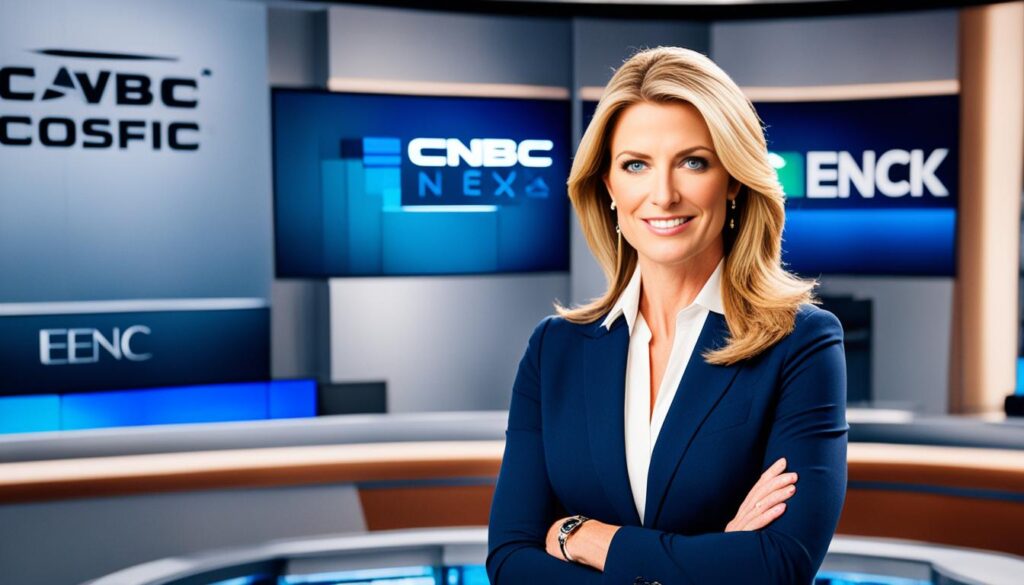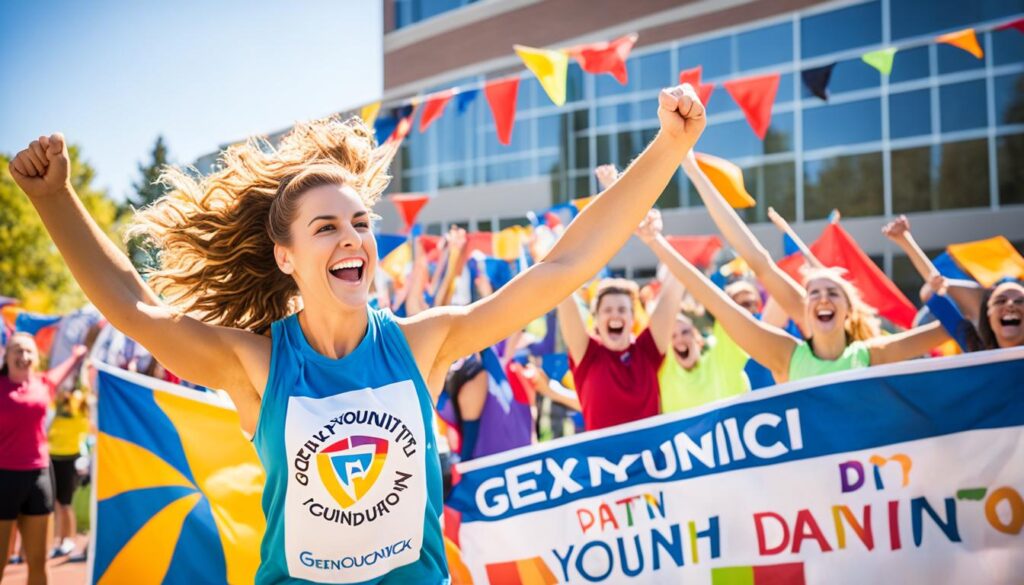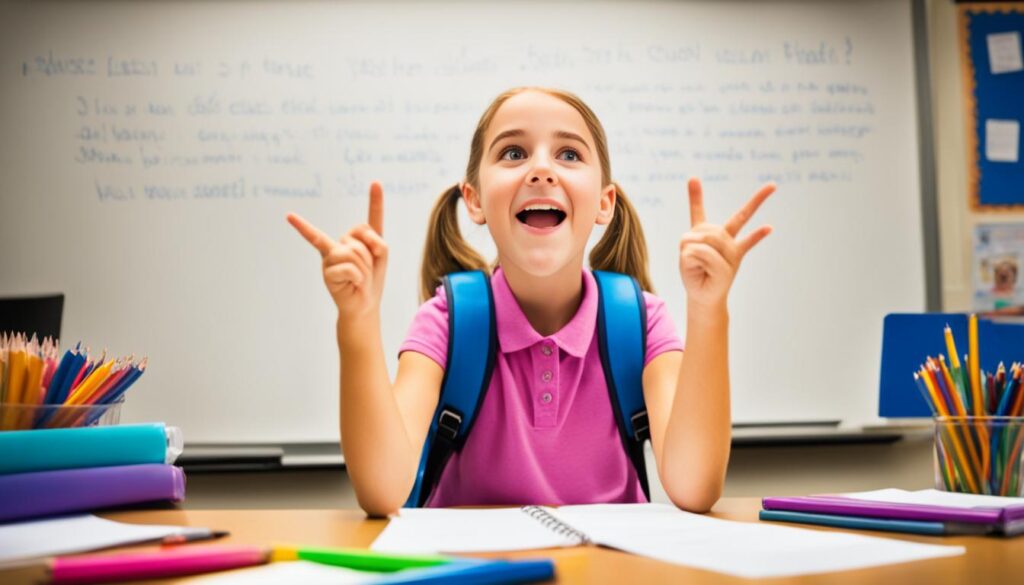Alexis Glick, once a CNBC anchor, is 5 feet 7 inches tall. But there’s more to her than just her height. Let’s explore her life and career’s interesting details.

Key Takeaways:
- Alexis Glick is a former anchor for CNBC and the CEO of the GENYOUth Foundation.
- She was born on August 7, 1972, and attended the Dalton School and Columbia University.
- Glick has had a successful career in finance, working at Goldman Sachs and Morgan Stanley.
- She is married to Oren Glick and has four children.
- Glick’s dedication to improving child health led her to establish the GENYOUth Foundation.
Early Life and Education
Alexis Glick was born on August 7, 1972, in the bustling city of New York. Her father, Robert E. Donnelly, was a well-known entertainment lawyer. Her mother, Ellen Cahill Donnelly, once worked as a secretary at Lehman Brothers.
She went to the Dalton School in Manhattan for her high school. There, Glick began shaping her academic path and personal development.
Glick then attended Columbia University for her higher studies. She chose Political Science for her Bachelor’s degree. This helped her deeply understand political systems.
Career at CNBC
Alexis Glick began her career journey at CNBC as a correspondent. She quickly made her mark with her talent and dedication. Soon, she became a prominent anchor, displaying her deep understanding and insightful reporting.
Glick interviewed famous people like President Barack Obama and Canadian Prime Minister Stephen Harper during her time at CNBC. She brought thoughtful discussions to the screen. Her interviews made her well-known as a seasoned journalist.
“Through my work at CNBC, I had the privilege of interviewing some of the most influential leaders of our time. It was an incredible opportunity to delve deep into their perspectives and share their insights with our viewers.”
After her impactful time at CNBC, Glick joined Fox News Channel. There, she was their Director of Business News. She continued to contribute greatly to journalism.
Glick also appeared as a guest commentator on CNN and ABC news. Her expertise made her a respected figure in the news world.
Throughout her career at CNBC and after, Alexis Glick became a well-respected journalist and anchor. She has left a lasting impact on media.

Personal Life
Alexis Glick’s life is full of love and joy. She is married to Oren Glick, who started Shoot Digital. This company is well-known in New York for photography. Their relationship shows their shared drive for success and support for each other.
The couple has four wonderful kids: Logan, Sky, Kyle, and Slate. Each one brings unique joy to their home. They make the Glick family’s world colorful and full of love.

The family is very close, thanks to their strong values. Alexis and Oren, along with their kids, make every moment count. They find happiness in being together, strengthening their family bond.
Achievements at Goldman Sachs and Morgan Stanley
Alexis Glick shined in the finance world before her time at CNBC. She left a mark at Goldman Sachs and Morgan Stanley.
Her Goldman Sachs start as an analyst was just the beginning. She quickly stood out. At Morgan Stanley, she broke records as the youngest woman to lead. She managed an operation at this top firm.
“I’m truly honored to have worked at Goldman Sachs and Morgan Stanley. The lessons and skills I learned have deeply influenced my path,” Glick remarked.
At Morgan Stanley, Glick flourished on the Listed Equity Trading Desk. From 1998 to 2001, she was one of the top achievers. Her skill in handling the finance world’s challenges was unmatched.
Her successes at Goldman Sachs and Morgan Stanley proved Glick’s leadership. They paved her way into the media sector.

Achievements at Goldman Sachs and Morgan Stanley:
| Company | Achievements |
|---|---|
| Goldman Sachs | Analyst in the Equities Division |
| Morgan Stanley | First and youngest woman to manage an operation in the bulge bracket firm’s history |
| Morgan Stanley | One of the top producers on the Listed Equity Trading Desk (1998-2001) |
Role at GENYOUth Foundation
Alexis Glick left Fox News with a goal in mind. She aimed to make a difference and did so by starting the GENYOUth Foundation. As the leader of GENYOUth, she worked with the NFL and the National Dairy Council. Together, they launched programs to help kids’ health and wellness.
GENYOUth Foundation works to make schools healthier places. They focus on children’s nutrition and exercise. With the help of big organizations, Glick’s team has boosted kids’ well-being across the U.S.
One main effort is the Fuel Up to Play 60 program. It encourages kids to stay active for 60 minutes daily and eat well. GENYOUth wants kids to lead by example and inspire healthy living in others.
Another effort is the AdVenture Capital program. It gives grants to schools for wellness projects. These projects let students lead their own health journeys, building leadership and empowerment.

Partnering for Impact: A Collaborative Approach
GENYOUth knows working together is key for real change. They teamed up with the NFL to inspire kids through athlete role models. The National Dairy Council helps, focusing on vital nutrients and dairy in diets.
GENYOUth’s CEO, Alexis Glick, celebrates teamwork, saying, “By working together, we can create a healthier future for our children by inspiring and empowering them to live their best lives.”
This team approach lets GENYOUth address many student needs. It combines efforts from teachers, leaders, and communities. This united effort drives change.
A Vision for the Future
Alexis Glick and GENYOUth have big plans for youth health. With creative programs and strong partnerships, they aim for a world where every child thrives. GENYOUth is committed to helping kids grow mentally, physically, and emotionally.
Looking ahead, GENYOUth will keep supporting our youth. By investing in them, we’re preparing a generation that will lead us into the future.
Social Media Presence
Alexis Glick is active on many social media sites, especially Twitter. As a former CNBC anchor, she has gained over 87,800 followers. Her posts, full of insights and experiences, have made her popular online.
On Twitter, Glick shares news, opinions, and engaging content from her media career. She uses this to connect with people and start valuable discussions.
“Social media provides a great opportunity to connect with people from different backgrounds and share experiences. I find it gratifying to engage with my followers, and it’s incredible to see the impact of these conversations on a broader scale.”
Her social media activities help her keep in touch with followers and widen her influence. She shares her knowledge and experiences, drawing attention and gaining new followers.
Alexis Glick’s social activities show her commitment to her career and her followers. It proves she’s dedicated to making personal connections online.

| Social Media Platform | Number of Followers | Number of Tweets |
|---|---|---|
| 87,800+ | 7,900+ | |
| Not Available | Not Available | |
| Not Available | Not Available |
Economic Impact on Education
The COVID-19 pandemic has deeply affected education budgets, causing big challenges. Schools across the country are struggling because of less money from taxes. They have to cut budgets by millions, which impacts their services.
School districts are merging schools to save money. This move aims to lower costs and use resources better. Yet, merging schools brings its own set of problems. It needs lots of planning and can upset students’ learning experiences.
Budget cuts also mean some teachers have to be let go. This is hard but sometimes necessary for balancing budgets. When there are less teachers, class sizes grow and learning can suffer.
The financial hit on education from COVID-19 shows we need to invest more in schools. The pandemic shows us how important a strong education system is. We must support our students by funding their education better.

To sum up, the pandemic’s economic effects have forced schools to cut back and let go of teachers. These tough times show the importance of investing in education. It’s the key to giving students what they need to do well.
Importance of School Meals
School meals are more than just food for kids. They are crucial for providing needed nutrition and support. With COVID-19, these meals have become even more essential for many families.
About one in six children lived in households struggling with food before COVID. It’s likely that more families are facing these challenges now. This shows how the crisis affects people all over the country.
For many kids, these meals are the main way they get healthy food. They get fruits, veggies, whole grains, and proteins. This way, school meals help meet the dietary needs of students.
These meals also boost students’ ability to learn. Kids who eat nutritious meals do better in school. They focus better, think more clearly, and behave better. This helps them learn and reach their goals.
School meals help families and communities, too. They take a load off families’ budgets and make sure kids get the nourishment they need. This helps keep families stable.
“School meals are a lifeline for many children, providing them with the nourishment they need to thrive academically and personally.”
During the pandemic, schools have found ways to keep feeding students. Many have set up grab-and-go locations where families can pick up food. These efforts are crucial for dealing with increased food insecurity.
Still, there are big challenges in getting meals to all students who need them. Schools are dealing with funding issues, logistics, and supply problems. Getting help from communities and policymakers is important to make sure no child goes hungry.
The Impact of School Meals
School meals do a lot more than feed students. They work towards a healthier, more fair future for all kids. They tackle food insecurity and make sure kids have access to the nutrition they need. Schools are key in supporting child nutrition and overall well-being.
As we deal with the pandemic’s challenges, keeping school meals a priority is crucial. By investing in these programs, we support kids, strengthen communities, and aim for a better future for the next generation.

Back-to-School Scenarios
Back-to-school plans differ widely across states and districts due to COVID-19. Schools are adapting to keep students and staff safe. They follow CDC guidelines for schools and use different methods to keep learning safe.
In-Person Learning
In-person learning is happening in some schools with safety measures. Students can go to school, meet friends, and learn together. But keeping everyone safe is vital. Schools use social distancing, masks, cleaning, and check for symptoms to stop the virus from spreading.
Hybrid Learning
A hybrid learning model is another choice. It mixes classroom and online lessons. This way, fewer students are in the classroom at once. It helps keep people apart safely. Students go to school some days and learn online on others. This mix helps keep learning personal but safe.
Distance Learning
Then there’s distance learning, where students learn fully online. This keeps education going from home. Students use computers and the internet to do school work and talk with teachers. It keeps everybody safe at home.
Choosing the right way to go back to school needs careful thought. It depends on local situations and what communities need. CDC guidance helps make these choices. School leaders, teachers, and parents all work together. They aim to help kids learn and stay well.

| Scenario | Description |
|---|---|
| In-Person Learning | Students attend classes physically with safety measures in place. |
| Hybrid Learning | Combination of in-person and online instruction to promote social distancing. |
| Distance Learning | Students engage in remote learning from home using technology and online platforms. |
Challenges for Student Athletes
The COVID-19 pandemic has greatly changed sports, impacting student athletes. School shutdowns and cancelled sports events have reduced physical activity for students. They also face reduced scholarship chances and academic opportunities.
A key problem for student athletes is missing competitions. Many sports seasons got called off or pushed back. This makes it hard for athletes to show their skills to college scouts. Now, they face tough competition for a few spots on college teams, adding pressure and uncertainty.
Training routines have also been upset by the pandemic. With the closure of gyms and sports facilities, athletes have had to find other ways to keep fit and sharpen their skills. They’ve become creative, doing workouts at home and training online.
Student athletes’ mental health is also suffering. They miss interacting with teammates and coaches. Plus, not knowing what will happen to sports in the future worries them. Schools and sports groups need to help students deal with these issues.
Student athletes are strong and committed, even in tough times like these. Their willingness to keep going shows their true spirit.
Now more than ever, schools and communities should help student athletes. Giving them access to training, mental health support, and academic assistance can lessen the pandemic’s effects on their futures in sports and school.
Impact of COVID-19 on Student Athletes
| Challenges | Impact |
|---|---|
| Loss of competitive opportunities | Limited chances to showcase skills and obtain scholarships |
| Disrupted training routines | Adapting to at-home workouts and virtual training sessions |
| Mental health concerns | Loss of social interaction and uncertainty affecting well-being |
Despite the hurdles, student athletes have stayed strong and determined. It’s crucial we acknowledge and back their efforts as they tackle these pandemic-related obstacles.

In the following section, we’ll look at how community support can help children and schools during these hard times.
Supporting Children and Schools
In these tough times, everyone must help kids and schools. The COVID-19 pandemic has changed education, bringing new challenges for children. With our support, we can help them overcome these problems and do well.
Teachers are key in helping kids learn and stay well. They are working hard to teach in new ways, especially online. Moms like Alexis Glick also inspire families and students by showing how important education is.
But help shouldn’t come from just parents and teachers. The whole community is needed. Groups, businesses, and volunteers can offer help, like resources, mentoring, and money. This helps all kids get a good education. By working together, we can build a future where all children succeed.